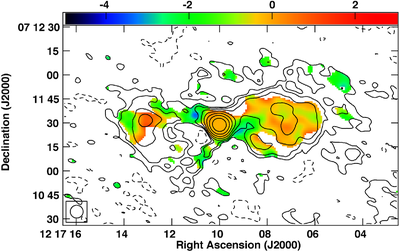Preeti Kharb
My research is related to the phenomenology of active galactic nuclei (AGN). In particular, I am interested in probing jet physics in AGN. While jets are ubiquitous among astrophysical objects, a comprehensive jet theory, is still missing. Jet creation, stability, collimation, composition, and magnetic field structure, are still a matter of debate. I describe below some of the projects we are engaged in to understand jet physics in AGN.
Understanding Jet Formation Through a Study of Radio-Quiet AGNs:
In order to understand jet-formation in AGN, we have been looking at the class of sources that have weak jets, but constitute the overwhelming majority of AGN, namely Seyfert galaxies. With Very Long Baseline Interferometry (VLBI) and VLA + GMRT experiments, we have been examining radio emission in Seyferts on both parsec and kiloparsec-scales. It is as yet not unambiguously clear if the AGN or nuclear starbursts are primarily responsible for the creation of Kiloparsec Radio Structures (KSRs) in Seyferts, with ample evidence supporting both scenarios in the literature. Based on the "radio-excess" (compared to the infrared flux) as well as the presence of parsec-scale jets in VLBI images, we have concluded that the radio lobes in several Seyfert galaxies are likely to be AGN-driven. VLBI observations of Seyfert galaxies that exhibit double-peaked emission lines in its optical spectrum, have revealed the parsec-scale base of an outflowing coronal wind in one case and a weak core-jet structure in another. The narrow-line clouds that produce the peculiar emission-line spectra, are likely to be a part of this outflow from the AGN in both cases. We are analyzing GMRT and VLA data on a large sample of Seyfert galaxies belonging to the S7 (Siding Spring Southern Seyfert Spectroscopic Snapshot Survey) sample. These low frequency data are revealing KSRs in a much larger fraction of Seyferts compared to previous studies. The radio data is being used in conjunction with the integral flux unit (IFU) optical data on these galaxies, to understand the close relationship (or not) between the jet and its surrounding medium. Low frequency GMRT data are also revealing the presence of "relic" emission in some Seyfert galaxies, pointing to restarted AGN activity in radio-quiet AGNs.
Understanding Jet Propagation Through a Study of Hybrid Blazars:
Hybrid blazars are radio-loud AGN that have a Fanaroff-Riley type I (FRI) jet on one side and an FRII jet on the other side of the radio core. Asymmetries in the surrounding medium is the favored explanation for the creation of such sources. We have been looking at Chandra + Hubble Space Telescope + VLA data of hybrid blazars belonging to the MOJAVE (Monitoring Of Jets in AGN with VLBA Experiments) sample. We have found that the majority of the hybrid sources showed FRII-like total radio powers, i.e., they are "hybrid" only in radio morphology but not in total radio power. VLBI observations of most of the sources show that the X-ray jet is on the same side as the one-sided VLBI jet. X-rays are therefore emitted from relativistically-boosted approaching jets. This is consistent with the X-ray emission being IC/CMB in origin in the majority of sources. It is not completely clear from our study that asymmetries in the surrounding medium can create hybrid sources. Hybrid radio morphologies could also be indicative of intrinsically asymmetric jets. We are currently in the process of expanding our sample and acquiring additional multi-wavelength data on these peculiar radio sources, in order to understand why jets of different morphology form on different sides of the core, in some radio-loud AGN.
We are engaged in a long-term program with the GMRT to image the radio lobes in Seyfert galaxies, that are often categorised as "radio-quiet" active galactic nuclei (AGN) in the literature. Not only have we detected larger lobes in several Seyfert galaxies, compared to observations from other radio telescopes operating at GHz frequencies, we have also detected suggestions of "relic" radio lobes in a couple of them. One such source is the Seyfert 1.2 galaxy, NGC 4235.
NGC 4235 is a nearby (redshift = 0.008) spiral galaxy. Radio observations of NGC 4235 were carried out in June, 2012 with the GMRT at 325 and 610 MHz. Both the 610 MHz total intensity image and the 325-610 MHz spectral index image of NGC 4235 hint at diffuse steep-spectrum radio emission just beyond the well-defined western lobe. This diffuse "relic" emission envelopes the western lobe: its shape resembles the shape of the western lobe and it has an extent that is roughly 1.5 times the extent of the western lobe. The average spectral index is -1.82 +/- 0.17 in this relic region. We attempted to obtain the relative ages of the two lobes on the western side of NGC 4235 by using the spectral-ageing formalism of Myers & Spangler (1985). The magnetic field was assumed to have the equipartition value of 5 microG. Using the electron spectral index of 2.0 for the Kardashev-Pacholczyk (KP) model, we obtain an age of ~40 Myr for the inner lobe and ~80 Myr for the outer "relic" lobe. This suggests that the "relic" radio lobe is two times older than the active lobe in NGC 4235. Our results have been published in Kharb et al. (2016).

The figure shows the 325-610 MHz spectral index image in colour overlaid with 610 MHz radio contours. The average spectral index is -0.6 in the lobes and <-1.8 in the "relic" lobe. The contour levels are in percentage of the peak intensity and increase by factors of 2. The peak intensity and lowest contour levels are 2.3 x 10^-2 Jy/beam and +/- 0.3 per cent, respectively. The contour image is convolved with a circular beam of size 8 arcsec.
Document Actions
